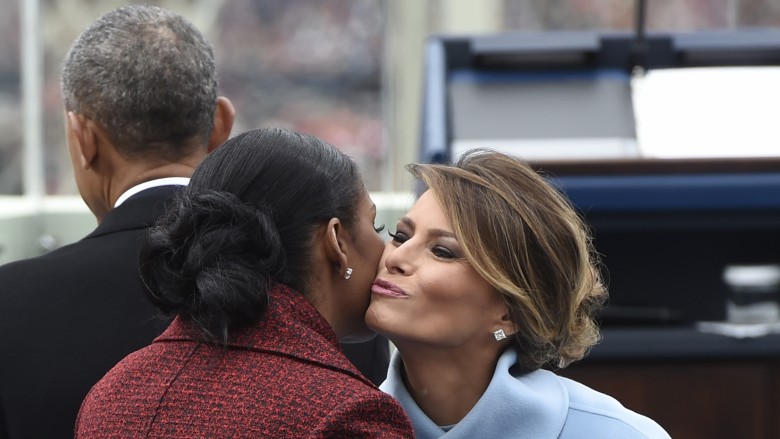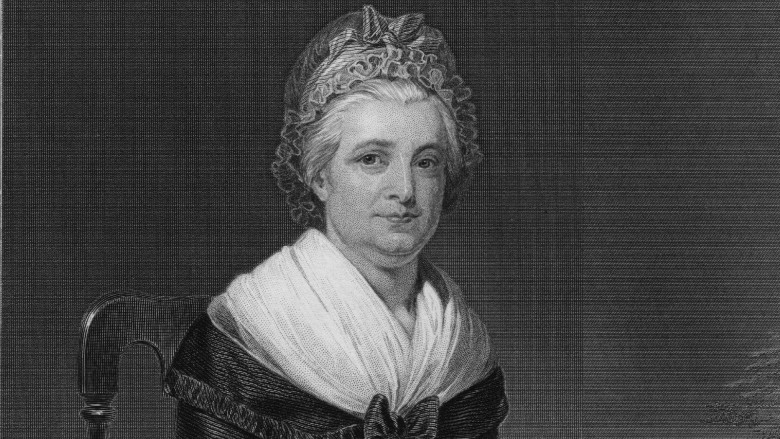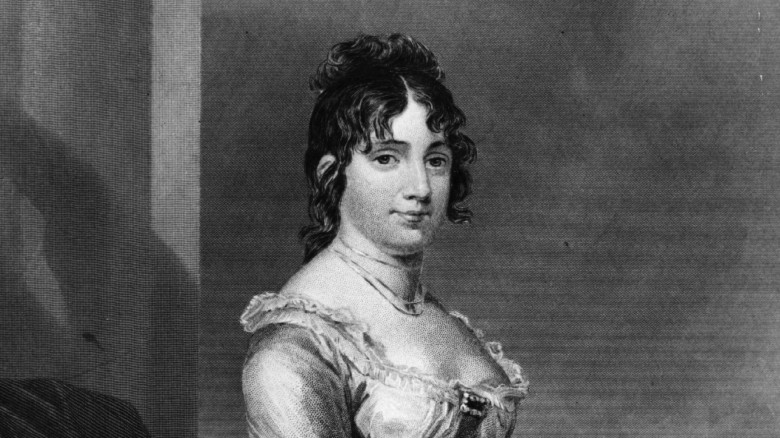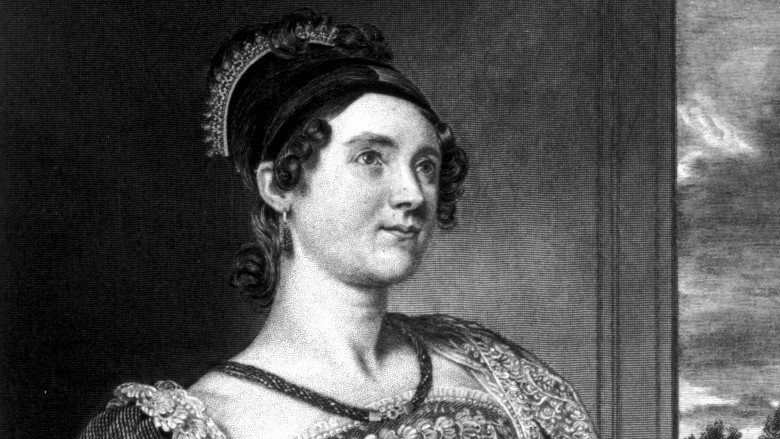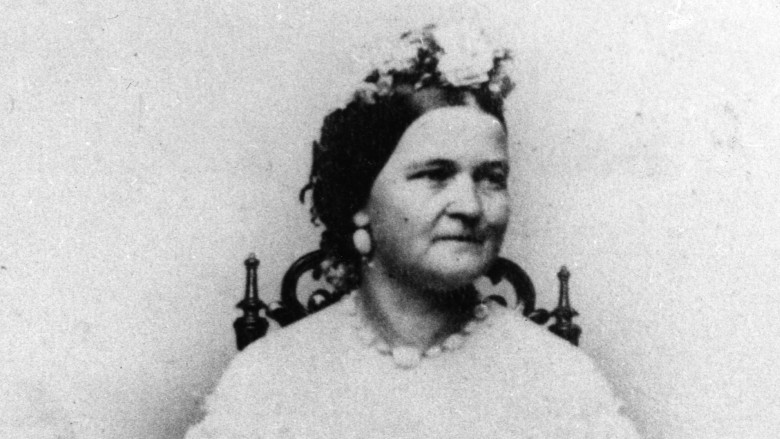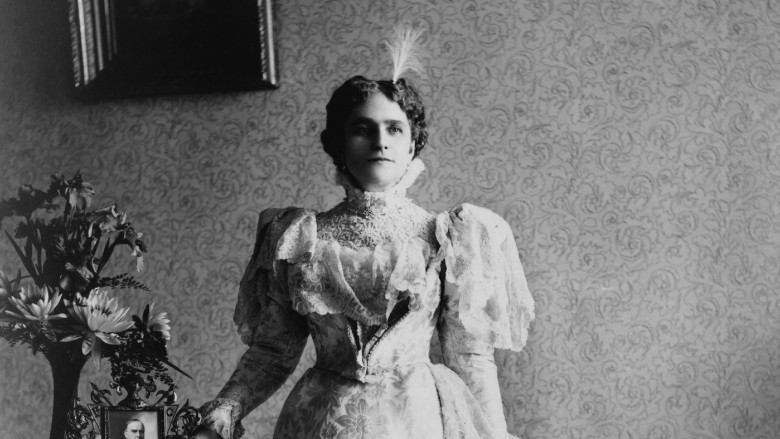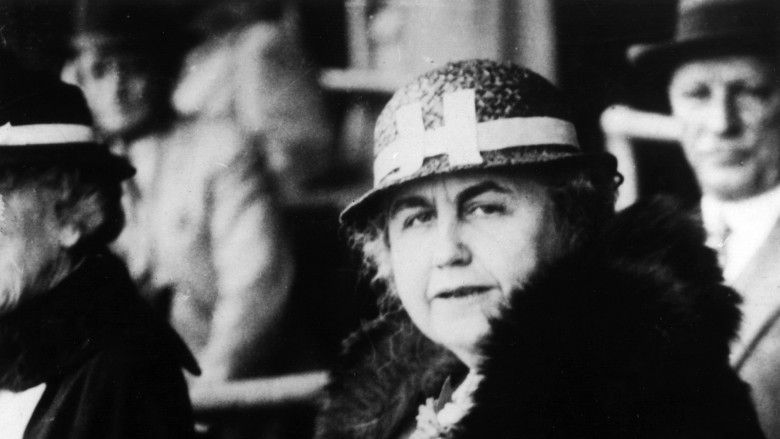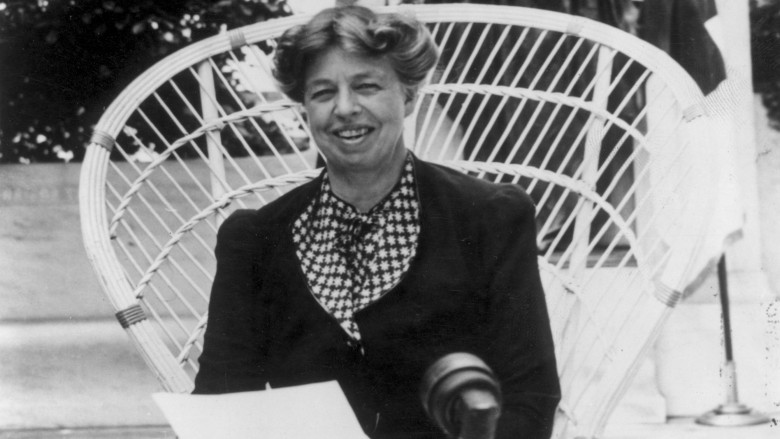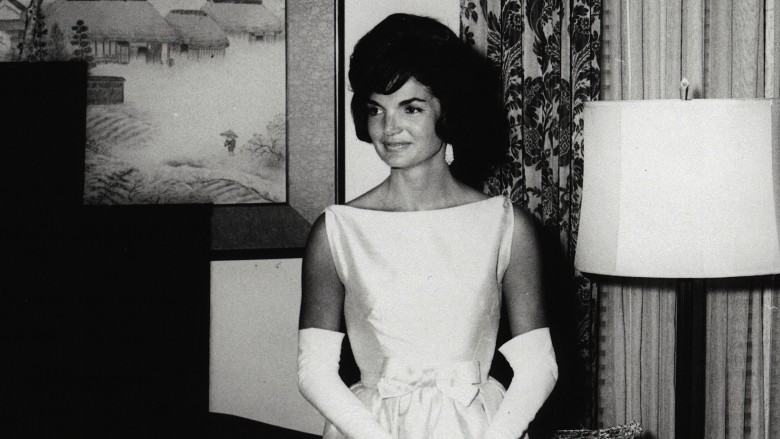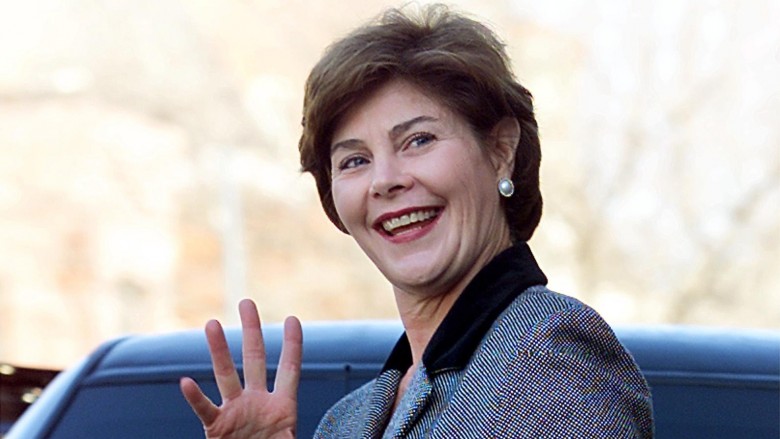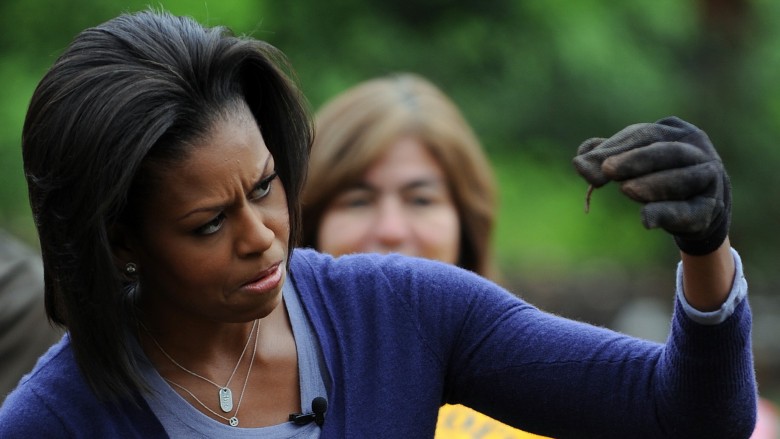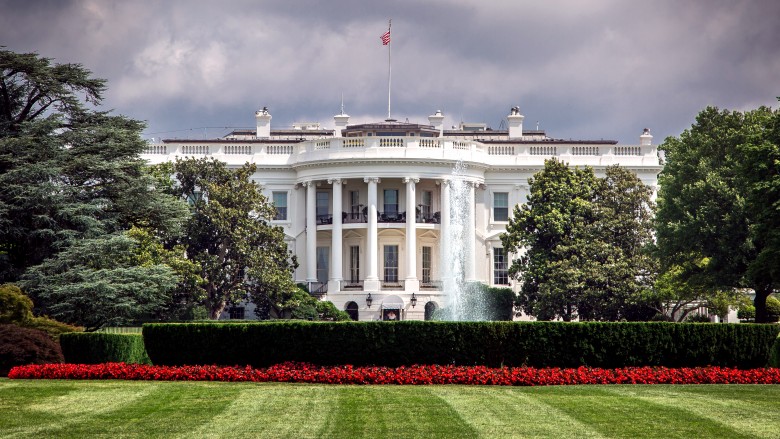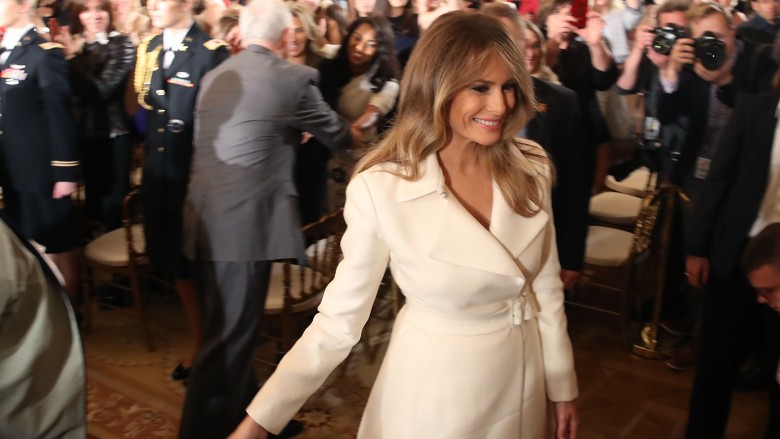The Untold Truth Of America's First Ladies
Landing the title of America's First Lady sounds like a glamorous gig, but not every woman in the role has loved being First Lady. Louisa Adams once said that "there is something in this great unsocial house which depresses my spirits beyond expression and makes it impossible for me to feel at home, or to fancy that I have a home anywhere."
And she wasn't the only person to feel cooped up in the White House. No wonder Michelle Obama made it a point to sneak out of the White House to go to places like Target, Petco, and Chipotle. Here's a look at some of the most remarkable FLOTUS tragedies and triumphs through the years.
First Ladies didn't get that title for a long time
There is no definitive answer as to how the term "First Lady" evolved. Dolley Madison was called "Lady Madison," and when she died in 1849, legend has it that President Zachary Taylor supposedly described her as "truly the first lady" in his eulogy for her.
John Tyler's wife Julia was reportedly called "Mrs. Presidentress" in 1844. And in 1858, when James Buchanan's niece Harriet Lane served as White House hostess for the bachelor president, Harper's Weekly dubbed her "Our Lady of the White House." Later, a journalist for Frank Leslie's Illustrated Newspaper called her "First Lady of the Land."
But the term didn't really catch on until Rutherford B. Hayes' wife Lucy (also known as "Lemonade Lucy" for her eschewing the serving of liquor in the White House) was called First Lady in 1877.
Martha Washington felt like a 'state prisoner'
Since Martha Dandridge Custis Washington was the first First Lady, she set the tone for the role, even though she didn't have the official title back then. Instead, people called her "Lady Washington" or "our Lady Presidentress" instead. When she met George Washington, Martha was a 26-year-old wealthy widow who had given birth to four children, with two surviving. Martha and Washington married in 1759, but they never had children of their own, and her two surviving children died before he became the nation's first president.
Martha was a true partner who lived at General George's Revolutionary War encampment each winter to give him moral support, and boost the troops' morale. This meant she had to be inoculated against smallpox, not an easy thing then.
Although she loved being with her husband there, she didn't want to leave their home at Mount Vernon when Washington became president, and reportedly found presidential years tougher than living in those war camps. She even described herself as a "state prisoner" when it came to that presidential life. Nonetheless, Martha graciously hosted many Americans during that time, welcoming visitors at a reception every Friday at the president's house (a temporary capital in New York, and later Philadelphia) when anybody could pay their respects.
Dolley Madison rescued a piece of history
Dolley Payne Todd Madison, the wife of James Madison, was an enormously influential First Lady, with a vivacious, fun personality. She first had experience in the role of First Lady before her husband was elected president. Dolley was Secretary of State to the widowed president Thomas Jefferson, and Dolley helped Jefferson out when he felt he needed a woman to help host events.
When she became the official First Lady in 1809, she held the first inaugural ball. And while in the White House, she created buzz by serving ice cream, a total showstopper at the time, since there were no freezers yet in existence.
But Dolley's most memorable moment was during the War of 1812. When the British invaded Washington, D.C. in 1814, and she had to flee the White House, she had a wagon filled with White House treasures sent off for safekeeping. Then she ordered her staff to save the famous Gilbert Stuart portrait of George Washington before fleeing, choosing to protect that over her personal items. The British then burned the White House, and she never got to live in it again, but her courage is still fondly remembered.
Louisa Adams binged on chocolate
Louisa Catherine Johnson Adams, born in England in 1775, was the first First Lady not born in the United States (Melania Trump is the second.) Louisa was known for throwing parties that helped John Quincy Adams' career and may have gotten him elected to the presidency. In 1824, the presidential election was to be decided in the House of Representatives due to the opponent Andrew Jackson, who won the popular vote, not having a majority of votes in the electoral college. The night before the vote, Louisa invited 67 House members to her house for one of her tea parties. The next day, Henry Clay, an opponent in the presidential race and the Speaker of the House, helped Adams win the election.
But this "corrupt bargain," as it was called, haunted her husband. Louisa became depressed. She also reportedly got sick from the fumes from the coal used for heating, binged on chocolate and even wrote a play that appeared to be a thinly-veiled look at her life. But things got better after Adams lost the presidency in 1828. She grew closer to him and helped with his abolitionist work. When she died in 1852, both houses of Congress adjourned for her funeral.
Mary Todd Lincoln was a shopaholic
Mary became one of the most controversial First Ladies in history, and was very unpopular for a variety of reasons, starting shortly after the 1860 election, when she went on a high-profile New York shopping spree. Word quickly leaked about her behavior and her "hellcat" temper. Her crazy shopping behavior continued throughout Honest Abe's presidency, as she rang up debt on ridiculous purchases, including 400 gloves in four months.
The death of their son Willie in 1862 due to typhoid fever sent her into a tailspin, amping up the shopping even more. She was so grief-stricken that many people, including Lincoln himself, worried about her mental health. By 1864, she had run up the equivalent of $400,000 in debt.
One year later, Mary would suffer the ultimate tragedy when Lincoln was assassinated in front of her. Her mental health would continue to deteriorate, and in 1875, her son Robert had her committed to an asylum, using her shopping sprees against her. She twice tried to kill herself there. Fortunately for her, Myra Bradwell, one of the country's first female lawyers, helped get Mary released after four months.
Ida McKinley's epileptic secret
Ida Saxton and William McKinley were a true love match when they married in 1871. But they faced numerous personal tragedies. Their two children died young, and she suffered from depression. She also started having epileptic seizures, but she tried to travel with her husband and help with his career as much as possible before her health deteriorated.
When he was running for president in 1896, rumors of her health threatened the campaign, but no one revealed exactly what was wrong with her. And she was even featured on campaign materials. After he was elected, the McKinleys still tried to act as if everything was normal with her health. When she met people at White House receptions, she would sit, holding a bouquet of flowers, so she didn't have to shake hands with the public. Violating the etiquette protocol of the time, he would sit next to her, instead of across from her, at state dinners to cover her face with a handkerchief in case she had a seizure.
President McKinley was assassinated in 1901, and succumbed to his injuries with Ida by his side.
Edith Wilson was the shadow president
Edith Bolling Galt married Woodrow Wilson in 1915, one year after his first wife Ellen died, making him one of the three presidents to marry while in office (John Tyler married Julia Gardiner in 1844, and Grover Cleveland married Frances Folsom in 1886). Wilson entrusted his wife with war codes and top-secret information, assignments beyond the role of a traditional First Lady. She also screened correspondence and guests and sat in on his meetings.
When World War I ended, the Wilsons traveled together to Europe to push for the signing of the Treaty of Versailles and the League of Nations. FirstLadies.org wrote that this appearance "put the position of First Lady on an equivalent standing" with queens.
Her already-heavy involvement with the presidency accelerated in the fall of 1919 when Wilson had a stroke and became partially paralyzed. She reportedly misled the country about Wilson's health and "became the sole conduit between the president and his cabinet, determining which matters were important enough to require his attention," according to History.com. While Edith claimed it was merely a "stewardship," historian Dr. Howard Markel writes for PBS, "She was, essentially, the nation's chief executive until her husband's second term concluded in March of 1921."
Eleanor Roosevelt's political marriage arrangement
Anna Eleanor Roosevelt and Franklin Roosevelt were distant cousins who married in 1905 and had six children (one died in childbirth). She was devastated to discover in 1918 that Roosevelt was having an affair with Lucy Mercer, her social secretary. She offered to divorce Roosevelt, but his wealthy mother Sara threatened to cut him off financially. So Eleanor agreed to stay married on two conditions: that he end things with Mercer, and that Roosevelt could never share her bed again.
For the next 27 years, the two had a political partnership only. Due to him becoming paralyzed from polio, she served as his "eyes, ears, and legs" throughout the Great Depression and World War II, traveling to support him in his four terms. Eleanor also had a very close friendship with reporter Lorena Hickok in the 1930s, that appeared to contain romantic elements.
When Roosevelt died in Warm Springs, GA in 1945, Eleanor learned that Mercer was with Franklin. Apparently he had never really ended the relationship. Not only did Eleanor feel another betrayal, but she was devastated to learn that their daughter Anna had arranged some of the Lucy liaisons. Eleanor later forgave her daughter.
Jackie Kennedy suffered a horrible loss before JFK's death
Jacqueline Lee Bouvier met John F. Kennedy at a dinner party and married in 1953. They wanted a family, but unlike her sister-in-law Ethel Kennedy who gave birth to 11 children, Jackie had difficult pregnancies with Caroline and John Jr., as well as a miscarriage, and a stillborn child. She had also had a troubled marriage, due in part to Kennedy's womanizing.
In 1963, Jackie was the first First Lady since Frances Folsom Cleveland to have a baby while her husband was in office. Patrick Bouvier Kennedy was born prematurely on August 7, 1963. The baby had respiratory distress syndrome, something he mostly likely would have survived, today. He lived just two days. JFK had grown up in a household where he was told that "Kennedys don't cry," but he wept after little Patrick died. The tragedy did bring the couple closer together. "There's just one thing I couldn't stand," Jackie told her husband, "If I ever lost you." He responded, "I know...I know." Three months later, Kennedy was assassinated.
Betty Ford's candor on breast cancer and addiction
Elizabeth Anne Bloomer Ford was arguably the first truly modern First Lady. She was a divorcee who studied and taught modern dance when she met future president Gerald Ford in 1947. They married and had four children as he pursued his political career. In 1973, Richard Nixon named Ford as vice president. Then, in 1974, as Nixon resigned, Ford became the only president not elected to office.
Betty Ford was outspoken on abortion, women's rights, and divorce. She even slept in the same White House bed as her husband, which was shocking at the time. Shortly after becoming First Lady, she found out she had breast cancer and had a mastectomy. Instead of keeping it quiet, as many women did back then, she went public with her struggle.
She also knew at the time she was First Lady, that she was developing a dependence on painkillers and alcohol, but was able to keep this under control when Ford was president. Things spiraled out of control when he lost in 1976. By 1978, her family held an intervention on her behalf. Betty got treatment and later founded the rehabilitation center that bears her name.
Laura Bush spent the morning of 9/11 with a Kennedy
Laura Lane Welch and George W. Bush only knew each other for three months when they got married in 1977. But the introverted librarian was a good match for the future president.
People remember that Bush was in an elementary school classroom when White House Chief of Staff Andrew Card told him, "A second plane hit the second tower. America is under attack" on September 11, 2001. But what is less well-remembered is where Laura was that day when she heard the news. According to Spoken From the Heart, her 2010 memoir, (via Today), Laura was on her way to the Capitol, slated to talk to the Senate Education Committee when she learned about the attack.
She met up with Senator Ted Kennedy. But instead of talking about what happened and looking at what was unfolding on the TV in his office, he made small talk with her. "I have often wondered if the small talk that morning was Ted Kennedy's defense mechanism," she wrote, "If after so much tragedy," including the assassinations of two brothers and the passing of his nephew John Jr. (Ted had to identify his body), "He simply could not look upon another grievous tragedy."
Michelle Obama brought back the White House garden
Michelle LaVaughn Robinson was Barack Obama's mentor at the law firm she worked at when they met in 1989. They married in 1992, had two children, Sasha and Malia, and moved into the White House in 2009.
Michelle's "Let's Move!" anti-childhood obesity program encouraged kids to eat better and exercise. But even before it launched, she set an example for the nation by creating a vegetable garden on the White House grounds in early 2009. This wasn't the first garden in presidential history: John and Abigail Adams grew vegetables, and Eleanor Roosevelt had a "victory garden" during World War II. But this was a much more ambitious endeavor. Michelle's garden has supplied food for both the Obamas and for visitors of the White House.
"It is my hope that our garden's story — and the stories of gardens across America — will inspire families, schools and communities to try their own hand at gardening," Michelle wrote in her 2013 book American Grown (via Mother Earth News), "And enjoy all the gifts of health, discovery, and connection a garden can bring." This legacy will live on: Melania Trump is going to keep Michelle's garden.
Three First Ladies died while in office
Most American students know about the eight presidents who died in office. William Henry Harrison, Zachary Taylor, Warren Harding, and Franklin Delano Roosevelt died of natural causes, and Abraham Lincoln, James Garfield, William McKinley, and John F. Kennedy were assassinated. But even adults may not be familiar with the fact that three First Ladies died in office as well.
Letitia Christian had suffered a stroke before her husband John Tyler was elected vice president in 1840 and was considered "an invalid." In fact, Tyler was going to stay with his wife in WIlliamsburg, VA when he was veep, instead of moving to Washington, D.C. But William Henry Harrison's death just a month into his term elevated Tyler to the presidency. Letitia had a second stroke in 1842 and died at the age of 51. Tyler would remarry while in office, to 21-year-old Julia Gardiner.
Caroline Harrison, wife of Benjamin Harrison, died of tuberculosis in 1892 at the age of 60.
And Ellen Axson Wilson, Woodrow Wilson's wife and an accomplished Impressionist painter, died in 1914 at age 56 of Bright's Disease. She reportedly told her physician when she was dying, to tell Wilson she would like him to remarry. He did, in 1915, to Edith Galt.
What will Melania Trump do as First Lady?
Each First Lady puts her own stamp on the White House, and on the position of First Lady. And many of the First Ladies have been incredibly popular — sometimes even more than their husbands.
It is unclear where Melania Trump will fall in that spectrum. She did make her own mark by revealing in 2017 that she would not move into the White House until the end of her and Trump's son Barron's school year in June. But she has several years ahead, in order to make a real splash.
The Washington Post described her in a 2017 article, "Melania Trump is a Rorschach test in Louboutins, inspiring praise from those who see in her inscrutable gaze an elegant, dutiful mother charting a new role for the first lady, compassion from those imagining her as the president's unhappy captive, her penthouse-turned-prison costing taxpayers ungodly sums to secure, and contempt from those rendering her as her husband's chief enabler..."
It remains to be seen what else she will do to make a statement as First Lady. But as we've learned, only FLOTUS knows what truly goes on just past the White House lawn.

